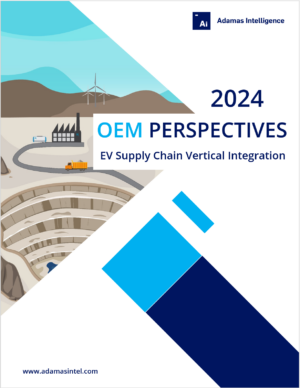Weekly Rare Earth Roundup with James Tekune – Week 11, 2024

CNRE injects another $278.4M into processing plant expansion
This week China Northern Rare Earth Group (CNRE) announced that it will inject a further $278.4M into its subsidiary Baotou Huamei Rare Earth High Tech (Huamei) that is upgrading and renovating its processing facilities in Baotou to be the world’s largest.
Once completed, the plant will have capacity process 198,000 tonnes of mixed rare earth concentrate annually (containing ~58% TREO) to produce approximately 107,000 tonnes of separated oxides and 39,600 tonnes of metals annually.
The latest injection follows an initial $1 billion investment by CNRE in March 2023 to upgrade the facility. Completion of the first phase of the project is expected in Q4 2024.
The group expects the project will yield an IRR of ~25% and return a payback on capital in just under 6 years.
Adamas take: With CNRE group receiving major production quota increases in the past two years, utilization of its existing processing capacity has reached atypically high rates meaning the Huamei upgrades cannot come soon enough.
CNRE anticipated ~6-year return on the ~$1.3 billion investment suggests the group is optimistic about the near- to medium-term for REO prices.
Arafura’s Nolans receives $550M from Australia govt
On Thursday, Arafura Rare Earths announced that its Nolans mine and refinery development project in the Northern Territory will be backed by a $533M debt finance package from the Australian Government.
The funding package will provide 15-year senior debt worth $333M through the Critical Minerals Facility (CMF) and the Northern Australia Infrastructure Facility (NAIF).
Export Finance Australia, which administrates the CMF, will provide an additional $200M in subordinated standby debt to support the project’s ramp up.
Arafura is currently in discussions with commercial banks for a further $550M of senior debt to support development.
Adamas take: A huge vote of confidence for Nolans and another step forward for Australia’s burgeoning critical minerals industry.
With a handful of rare earth mining and processing projects advancing in the nation, the government’s focus now should be on closing downstream gaps that will ensure future mine supplies can be converted into the metals, alloys and magnets OEMs need.
US, Europe automakers sign deals with POSCO International
POSCO International, a subsidiary of South Korea’s POSCO Group, announced this week that it has entered into agreements worth $885 million to supply rare earth permanent magnets to North American and European automakers.
The announcement specified that its magnets will be produced from rare earth oxides sourced from the U.S., Australia and Vietnam as the company aims to establish an independent supply chain.
The deals secured by POSCO’s U.S. and German subsidiaries will see delivery of $685M worth of magnets to North American automakers from 2026 through 2031.
Its European contract(s) will see it supply a further $200M of magnets to a premium automotive brand from 2025 through 2034.
Adamas take: After surprising the market with its plans to build an NdFeB magnet factory in North America last year, POSCO is wasting no time closing deals for its planned production.
As described, the agreements stand to benefit MP Materials in the U.S., potentially Lynas, Iluka and Arafura in Australia, and unknown entities in Vietnam that will supply raw materials.
16,000 tonnes of rare earth oxides illegally mined in Malaysia
The Malaysian Minister of Natural Resources, Nik Nazmi, stated on Tuesday that an estimated 16,000 tonnes of rare earth oxides have been illegally mined and shipped to China in the past year or so.
He disclosed during this week’s parliamentary question session that illegal mines operations have been located in forest reserves in the states of Kedah, Pahang and Perak.
Mr. Nazmi cited a report from China that concluded that 19,081 tonnes of REO were imported from Malaysia in recent years. Of that amount, only 3,000 tonnes of REO were legally produced by a state-owned pilot project in Kenering, Perak.
He acknowledged a lack of a comprehensive policy and development plan for the nation’s rare earth industry has left the door open for illegal operations. At the start of the year, the government put a moratorium on export of unprocessed REEs and will review it every six months going forward.
Adamas take: According to China customs data reviewed by Adamas, China imported ~1,100 tonnes of MREO, ~8,500 tonnes of MREC and ~300 tonnes of monazite from Malaysia last year calling into question the source of the data underlying Mr. Nazmi’s claim.
Solvay, Carester forge strategic partnership
Solvay and Carester last week announced the formation of a strategic partnership to pursue rare earth permanent magnet manufacturing in Europe. The partnership aims to leverage Solvay’s industrial assets and operational strength along with Carester’s expertise in processing and recycling end-of-life products to enhance European rare earths supply.
Solvay’s operations in La Rochelle, France produce around 4,000 tonnes of rare earth formulations annually. In 2022, it expanded its product line to include separated oxides for permanent magnets.
In Q3 2024 Carester will begin construction of their CAREMAG processing and recycling facility in Lacq, France. The plant operations will launch in Q1 2026 and will produce Nd, Pr, Dy and Tb oxides from virgin feed, swarf, scrap and end-of-life permanent magnets.
Adamas take: In February of last year, Solvay signed an MoU with Cyclic Materials for supply of recycled mixed rare earth oxides from the latter’s plant in North America. The latest partnership with Carester will further strengthen Solvay’s magnet supply chain, especially for the much-needed heavy rare earths.
Lead engineers appointed for HyProMag USA feasibility study
At the start of the week, Mkango Resources and CoTec Holdings announced the selection of BBA USA and PegasusTSI to lead the HyProMag USA feasibility study. The appointed experts will use a hub-and-spoke model to engineer and design three REE magnet recycling plants around the U.S. and one magnet production facility in Texas.
HyProMag USA, a 50/50 joint venture between Mkango’s subsidiary Maginito and CoTec, will use its patented Hydrogen Processing of Magnet Scrap (HPMS) technology at the recycling plants to recover NdFeB powder from EOL magnets.
The companies expect the feasibility study to be completed in H2 2024, with potential site acquisition towards year-end and production to start in 2025/2026.
Adamas take: HyProMag is currently ramping up to commercial production of sintered NdFeB magnets at their Tyseley facility in Birmingham, UK.
Production is anticipated to commence in H2 2024 at rate of 20 tpa and will be scaled up to 100 tpa in the months to follow. The U.S. feasibility study will assess the production of 500 tpa of NdFeB magnets from recycled feeds.
James Tekune, Associate at Adamas Intelligence
James is an Associate at Adamas focused on the global rare earths industry. He tracks and analyzes exploration and development projects, emerging processors and recyclers, and end-users around the world.
James has 3 years experience in mining and geophysics in the nickel, iron and gold sectors.
He completed his Bachelors of Science (Hons) in Geology at Laurentian University in Sudbury, Ontario. He also holds credentials in Finance and Geographic Information Science.
Rare Earth Market Intelligence:
Rare Earth Magnet Market Outlook to 2040
In this report, we provide a detailed overview of the global NdFeB alloy, powder, magnet and magnet rare earth oxide markets, including a breakdown of historical production, consumption and prices from 2015 through 2022. Next, we unravel the anticipated near-term impacts of the pandemic recovery on world markets and forecast global supply, demand and prices from 2023 through 2040.
Rare Earth Pricing Quarterly Outlook
The ‘Rare Earth Pricing Quarterly Outlook’ subscription-based report looks back on the rare earth market’s performance over the trailing three months and details Adamas Intelligence’s latest near-term and long-term rare earth oxide (“REO”) price forecasts to 2040.
Rare Earth Minerals Monthly
The ‘Rare Earth Minerals Monthly’ is a subscription-based report and data service for tracking global rare earth minerals trade, mineral concentrate prices, rare earth oxide prices, payability ratios, and other key developments on the supply- and demand-side of the market month-after-month.
EV Motor Materials Monthly
The ‘EV Motor Materials Monthly’ is a subscription-based report and data service for tracking motor demand, NdFeB magnet demand, and other key developments in the global EV traction motor market month-after-month, as they happen; by region, country, motor type, EV type, EV make, EV model and motor supplier, plus the latest developments in rare earth and NdFeB alloy prices.






